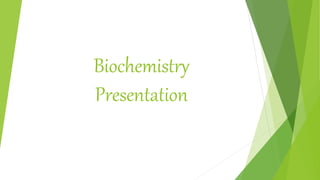
Protein and it's structure and functions
- 2. Topic Protein Primary Structure Secondary Structure Tertiary structure Quaternary structure Biological significance
- 3. Protein: Proteins are the most abundant organic molecules of the living system. They constitute about 50% of the cellular dry weight. They constitute the fundamental basis of structure and function of life.
- 4. In 1839, Dutch chemist G.J. Mulderwas first to describe about proteins. The term protein is derived from a Greek word proteios,meaning first place. The proteins are nitrogenous macromolecules that are composed of many aminoacids.
- 5. Amino Acids Amino acids are a group of organic compounds containing two functional groups –amino and carboxyl. The amino group[ -NH2] is basic while the carboxyl group [COOH] is acidic in nature. There are about 300 aminocids occur in nature. Only 20 of them occur in proteins.
- 6. Structure of Amino Acid Each amino acid has 4 different groups attatchedto αcarbon ( which is C atom next to COOH).These 4 groups are : amino group, COOH group , Hydrogen atom and side chain(R).
- 7. Peptide bond formation α-carboxyl group of one amino acid (with side chain R1) forms a covalent peptide bond with α-amino group of another amino acid (with side chain R2) by removal of a molecule of water. The result is : Dipeptide.
- 8. The dipeptidecan then form a second peptide bond with a third amino acid( with side chain R3) to give tripeptide. Repetition of this process generates a polypeptide or protein of specific aminoacidsequence. Has 40% double bond character, caused by resonance.
- 9. Structures of protein Proteins have different levels of organisation Primary Structure Secondary Structure Tertiary Structure Quaternary Structure
- 11. Primary Structure The primary structure of protein refers to the sequence of amino acids present in the polypeptide chain. Amino acids are covalently linked by peptide bonds or covalent bonds. Each component amino acid in a polypeptide is called a " residue” or “moiety”. By convention the primary structure of protein starts from the amino terminal (N) end and ends in the carboxyl terminal (C) end.
- 12. Secondary Structure It is a local, regularly occurring structure in proteins and is mainly formed through hydrogen bonds between backbone atoms. Pauling & Corey studied the secondary structures and proposed 2 conformations o αhelix o βsheets.
- 13. Tertiary structure The tertiary structure defines the specific overall 3-D shape of the protein. Tertiary structure is based on various types of interactions between the side-chains of the peptide chain.
- 14. Tertiary structure stabilization In globular proteins Tertiary interactions are frequently stabilized by sequestration of hydrophobic amino acid residues in the protein core. Consequent enrichment of charged or hydrophilic residues on the protein's water-exposed surface. In secreted proteins Di-sulfide bonds between cysteine residue helps to maintain the protein's tertiary structure
- 15. Interactions in tertiary structure 1. Disulfide bonds 2. Hydrophobic interactions 3. Hydrogen bonds 4. Ionic interactions 5. Vander Waals force
- 17. The quaternary protein structure involves the clustering of several individual peptide or protein chains into a final specific shape. A variety of bonding interactions including hydrogen bonding, salt bridges, and disulfide bonds hold the various chains into a particular geometry. Two kinds of quaternary structures: both are multi subunit proteins. Homodimer : association between identical polypeptide chains. Heterodimer: interactions between subunits of very different structures. The interactions within multi subunits are the same as that found in tertiary and secondary structures
- 18. Biological Significance of Proteins